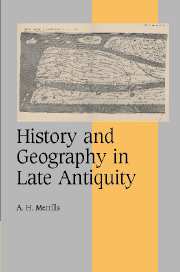Book contents
- Frontmatter
- Contents
- Preface
- A note on translations
- List of abbreviations
- Introduction: history's other eye
- 1 Orosius
- 2 Jordanes
- 3 Isidore of Seville
- 4 Bede
- 5 Conclusions
- Appendices
- A The geographical introduction to the Historiarum adversus paganos libri septem of Orosius. Orosius, Hist. i.1–106
- B The geographical introduction to the De origine actibusque Getarum of Jordanes. Getica i.4–v.38.
- C The Laus Spaniae of Isidore of Seville
- D The description of Britain in Bede, Historia Ecclesiasticai.1
- References
- Index
- Cambridge Studies in Medieval Life and Thought Fourth series
D - The description of Britain in Bede, Historia Ecclesiasticai.1
Published online by Cambridge University Press: 24 July 2009
- Frontmatter
- Contents
- Preface
- A note on translations
- List of abbreviations
- Introduction: history's other eye
- 1 Orosius
- 2 Jordanes
- 3 Isidore of Seville
- 4 Bede
- 5 Conclusions
- Appendices
- A The geographical introduction to the Historiarum adversus paganos libri septem of Orosius. Orosius, Hist. i.1–106
- B The geographical introduction to the De origine actibusque Getarum of Jordanes. Getica i.4–v.38.
- C The Laus Spaniae of Isidore of Seville
- D The description of Britain in Bede, Historia Ecclesiasticai.1
- References
- Index
- Cambridge Studies in Medieval Life and Thought Fourth series
Summary
TRANSLATION TAKEN FROM BERTRAM COLGRAVE AND R. A. B. MYNORS, BEDE'S ECCLESIASTICAL HISTORY OF THE ENGLISH PEOPLE (OXFORD, 1969), pp. 14–20
Britain, once called Albion, is an island of the ocean and lies to the northwest, being opposite Germany, Gaul and Spain, which form the greater part of Europe, though at a considerable distance from them. It extends 800 miles to the north, and is 200 miles broad, save only where several promontories stretch out further and, counting these, the whole circuit of the coast line covers 4,875 miles. To the south lies Belgic Gaul, from which the city called Rutubi Portus (Which the English now corruptly call Reptacaestir) is the nearest port for travellers. Between this and the closest point in the land of the Morini, Gessoriacum, is a crossing of fifty miles or, as some writers have it, 450 stadia. Behind the island, where it lies open to the boundless ocean, are the Orkney islands.
The island is rich in crops and trees, and has good pasturage for cattle and beasts of burden. It also produces vines in certain districts and has plenty of both land- and waterfowl of various kinds. It is remarkable too for its rivers, which abound in fish, particularly salmon and eels and for copious springs. Seals as well as dolphins are frequently captured and even whales; besides these there are various kinds of shellfish, among which are mussels, and enclosed in these there are often found excellent pearls of every colour, red and purple, violet and green, but mostly white.
- Type
- Chapter
- Information
- History and Geography in Late Antiquity , pp. 329 - 331Publisher: Cambridge University PressPrint publication year: 2005



